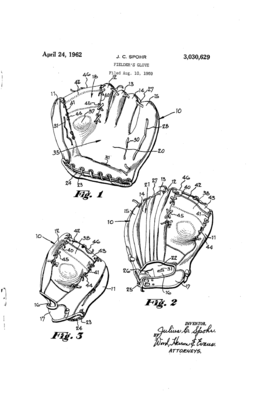Rawlings, going through them changes

Posted:
August 30th, 2010, 1:21 amby mikesglove
Re: Rawlings, going through them changes

Posted:
August 30th, 2010, 4:32 pmby softball66
Good post Mike about those transition periods for Rawlings. Do you have info on what other companies Figgie had in its portfolio at the time it owned Rawlings? Seems I remember lawn supplies (A-T-O) but could be wrong. And, did Figgie sell off Rawlings to someone? Or did private investors take it back over?
I assume you're saying that Rawlings got back a share of its professional user market after 1958 and the W. A2000 made serious inroads to MLP using Wilsons instead of Rawlings. And not sure when that might have peaked. Rawlings employee told me that the Spalding Warehouse was right across the street from the Rawlings' Ava plant. In most cases the Rawlings and Spalding gloves were identical. I wish someone had done polls of what players used in the 1960s and '70s.
SOME ADDITIONAL INFO
Harry E. Figgie Jr., who died early Tuesday, (2009) built a Fortune 500 company with dramatic ups and downs. The demanding, wisecracking, risk-taking entrepreneur and best-selling author put together Figgie International, which grossed up to $1.5 billion per year. The conglomerate bought and sold widely ranging ventures, from Rawlings Sporting Goods to American LaFrance fire trucks to Fred Perry Sportswear. The headquarters of what Figgie Jr. called the "free form company" shuttled from Youngstown to Willoughby to Virginia and back to Willoughby, spurring development, sending careers and tax revenues up and down.
Figgie Jr. died at age 85 at a local health-care facility.
"He was a visionary," Darrell Young, former president of Figgie Properties, said Tuesday.
Re: Rawlings, going through them changes

Posted:
August 30th, 2010, 11:53 pmby mikesglove
Hi Joe, Here is the link I have for Rawlings history:
http://www.answers.com/topic/rawlings-sporting-goods-co-incThere was an interesting statement in the article about the 4 top Sporting goods companies circa 1954. Spalding was #2 and Rawlings #4. The article did not say who was #1 and #3. I would think it would be Wilson #1and MacGregor #3 respectively. What do you think?
I think the article stated Figgie had 30 different companies at one time. Didn't list them all, although I know A-T-O Lawn Sprinklers was a Figgie acquistion. Rawlings was a branch of A-T-O if you can believe that! As far as MLB, You are right. Wilson and the A2000 was the leader among ball players until Figgie took control in 1967 and then Rawlings made more advances among MLB players. When Figgie sold off Rawlings in 1994 it was to private investors and not another conglomerate. This is good info you have on Harry Figgie
Mike
Re: Rawlings, going through them changes

Posted:
August 31st, 2010, 10:08 amby softball66
Mike, you're bang on! I think the Wilson A2 caught Rawlings flat footed though Elmer Blasco wouldn't credit it when I interviewed him years ago. He said Harry and Rollie already had ideas similar.
I think they were caught up in the Trapeze at the time. Wilson's endorsed players esp. dropped their Rawlings gloves and hugged their new A2000s! New ballgame as they say.
You're right about Wilson because Wilson had a broader base of popular products besides gloves: golf, tennis, football and we got the impression Rawlings was of good size because of its early dominance of ball gloves. Spalding was on a decline in the 1950s and '60s, eventually to become a shell and ditto for MacGregor.
It's always beneficial to get the big picture and gather new input on the companies and the glove market!
Re: Rawlings, going through them changes

Posted:
August 31st, 2010, 12:50 pmby mikesglove
Hi Joe, I remember you writing once how the advent of the A2000 shook up the industry. It was a beautiful, classic design. The Rawlings "Trapeze" was more revolutionary and took a lot longer to catch on. I was looking at that Trapeze patent a while ago and noted a patent by MacGregor that was similar to Harry Latina's design but lacked Latina's creative flair

- note the web and pocket as one piece. patented in 1962 by MacGregor

- The "Trapeze" patent by Harry Latina for Rawlings in 1963